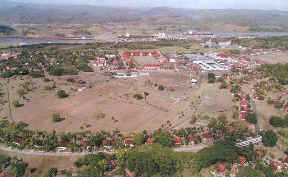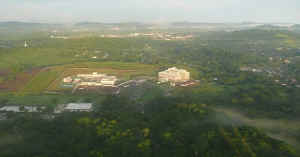|
 >>> >>>
FOCUS ON:
PANAMA CANAL TREATY
TRANSITION.... 1979-1999
Summary of Treaty
Transition Milestones
Military Property
Transfers to Panama
Treaty Impact on Military
|
MILITARY
PROPERTY TRANSFERS (1979-1999) (continued)
| DATE |
PROPERTY
|
REMARKS |
| 1999/
Nov 30 |
Fort Clayton (Pacific
side across Gaillard Highway from Miraflores Locks of the Panama
Canal)
 | Site of Headquarters, U.S.
Army South (U.S. Southern Command's Army component) since
October 1979.
 | 2,180 acres with:
 | Major office buildings
(Building 95 and quadrangle buildings), post office,
several other barracks buildings and barracks converted to
offices buildings. Building 519 offices complex (former
hospital), Southern Command Radio and Television Network
building, and other buildings;
 | Recreation center,
gymnasium, bowling alley, chapel, swimming pool, theater,
two community clubs, teen center, laundromat, community
park;
 | Automotive service garage,
gas station (Curundu), fire station (PCC), Curundu
elementary school and Fort Clayton elementary school,
pre-school facility, motorpool facilities, police station
and detention facility;
 | 1,392 family housing units
and transient quarters (guest house). |
 | Market value of Fort
Clayton: $862,000,000 (replacement cost --$2.5 billion). |
| | |
|
|
Last major units at Fort
Clayton:
 | Headquarters, U.S. Army South
(USARSO) (last USASRSO commanding general in Panama -- Major
General Philip R. Kensinger, Jr.)
 | Theater Support Brigade
 | 245th Support Battalion (which
included 534th Military Police Company, 1097th Transportation
Company (Waterborne), 193d Supply and Transportation Company,
786th Explosive Ordnance Company, 911th Maintenance Company,
and 79th Army Band
| | |
|

FORT CLAYTON,
near the Miraflores of the Panama Canal (in background),
was the headquarters of U.S. Army South, U.S. Southern
Command's Army component. The Quadrangle (upper center)
housed primarily the Command Group elements of Army South,
534th Military Police Company, 79th U.S. Army Band,
headquarters of 128th Aviation Brigade. U.S. Army
Communications Agency, an elementary school and
library. In the foreground, the community park and former
Colonels Row family housing. [Photo from City of Knowledge
brochure]
|
USE BY PANAMA:
City of Knowledge (Ciudad
del Saber) -- The largest entity now at Clayton, the City
of Knowledge is a new concept (for Panama) of a major international center of
Inter-American consortium of academic institutions, scientific
and technical advanced research and innovation centers, along
with a technology park (companies manufacturing and developing
products of high and medium technology for export), cultural
institutions, and nongovernmental organizations. The
Centerís mission is to promote and facilitate synergy
between universities, research centers, scientific
organizations, business of the new economy and international
organizations.
 | It is under the
direction of the City of Knowledge Foundation created in 1995
as a private, nonprofit organization. The
concept is based on the feasibility study prepared by the
Academy for Educational Development (AED) in Washington, D.C.,
and the strategic plan prepared by UNESCO. |
 | The City of Knowledge
is established, since 2000, in a 296-acre (120 hectares) area
that includes 71 buildings and 369 housing units in the
Quadrangle and nearby areas. The administrative offices
and principal staff of the
City of Knowledge are located in Building 95 on the
Quadrangle. The Technical/Industrial Park encompasses
all the buildings around the field formerly known as Sykes
Field. |
 | Laboratory area in the
400 housing area. Housing and recreation area associated with
the City of Knowledge include the 800 housing area, the
community park, swimming pool, gymnasium, Colonels Row housing
area, and the 300 housing area. |
 |
As of July 2004, the City of Knowledge complex has 16
academic programs, offices of 12 international organizations,
and 30 foreign and Panamanian business enterprises operating
in its Technopark. The industrial park has generated (as of
July 2004) about 250 jobs, with another five businesses
expected to be established there by the end of 2004. 48
percent of the 200,000 square meters of buildings and other
facilities received by the City of Knowledge has been filled.
(El Panama America, 26 July 2004)
|
 |
The International Tecnopark will be receiving a donation
from the European Union of 11.3 million Euros for a five year
period. The major part of the donation is expected to be
transmitted to the City of Knowledge in 2005 and 2006.
|
 Water
Center for the Humid Tropics of Latin America and the Caribbean (CATHALAC)
Water
Center for the Humid Tropics of Latin America and the Caribbean (CATHALAC)
 SERVIR
- MesoAmerican Monitoring and Visualization System (NASA)
at City of Knowledge. Its website is http://servir.nsstc.nasa.gov/globeintro.html.
SERVIR is headquartered at Water
Center for the Humid Tropics of Latin America and the Caribbean (CATHALAC)
in the City of Knowledge, Clayton, Panama. SERVIR is primarily
funded by NASA and the United States Agency for International
Development (USAID). The SERVIR webpage (http://servir.nsstc.nasa.gov)
provides free and open access to: (1) Satellite and other spatial
data sets via MesoStor; (2) Interactive online maps: (3) Thematic
decision support tools; and (4) 3-D interactive visualizations.
NASA inaugurated the center early
Feb 2005.
SERVIR
- MesoAmerican Monitoring and Visualization System (NASA)
at City of Knowledge. Its website is http://servir.nsstc.nasa.gov/globeintro.html.
SERVIR is headquartered at Water
Center for the Humid Tropics of Latin America and the Caribbean (CATHALAC)
in the City of Knowledge, Clayton, Panama. SERVIR is primarily
funded by NASA and the United States Agency for International
Development (USAID). The SERVIR webpage (http://servir.nsstc.nasa.gov)
provides free and open access to: (1) Satellite and other spatial
data sets via MesoStor; (2) Interactive online maps: (3) Thematic
decision support tools; and (4) 3-D interactive visualizations.
NASA inaugurated the center early
Feb 2005.
 | Schools at Clayton
include Balboa Academy (in Buildings 128 - junior high
school, 129 - elementary classrooms and adjacent sports field,
130 - high school, and 39 - primary classrooms and play area); Esclavas School (previously located near Paitilla
Circle in Panama City) in the former Curundu Elementary School
near the back gate to Clayton. |
 | UNICEF (United Nations Childrenís Fund) new regional
headquarters (Building 131) |
 | U.S. Embassy at Clayton
-- The new U.S.
Embassy complex was inaugurated September 18, 2007 by
Ambassador William Eaton and Panama's First Vice President and
Foreign Minister Samuel Lewis Navarro. The site (which includes part of the Cardenas
area) is near the Esclavas School (in the former Curundu Elementary
School) near the back gate entrance to Clayton. (The Esclavas
School was previously near Paitilla circle in Panama
City.) Construction began in early 2005 on the estimated $67 million
complex that now houses the U.S. Embassy previously on Balboa Boulevard
in Panama City since 1942 and other U.S. Government agencies
in Panama City. |
 |
| New
American Embassy near the back gate to Clayton [La
Prensa, Sept 19, 2007] |
|

|
| Aerial of
the new U.S. Embassy at Clayton (in the center of the
photo) with the front part of Clayton in the far
background. [Photo by Allan Hawkins, August 2007] |
 | The U.S.
Consulate moved from downtown Panama City to Building 520
(next to Building 519) at Clayton temporarily in 2006 and moved into the new
Embassy complex in September 2007. |
 |
| The U.S.
Consulate was in Building 520 at Clayton (next to Building
519) temporarily since 2006
until September 2007 when construction of the new U.S. Embassy at Clayton
was completed. [Photo
by Allan Hawkins] |
|
Army Property
Clayton-History
Clayton-New
Use
|
| 1999/
Dec 6 |
Corozal
West complex (Pacific
side, west side of Gaillard Highway, between Fort Clayton and
Albrook)
322 acres (total for
Corozal East and West)
COROZAL WEST:
 | Army transportation facilities
and motorpool, |
 | Engineering and housing
administration facilities, |
 | Army printing plant, |
 | Army Corps of Engineers
offices, |
 | Army Directorate of Logistics
offices, |
 | Army and Air Force Exchange
System (AAFES) main retail facility, |
 | Army communications
facilities, |
 | Army Contracting Office, |
 | Defense Reutilization and
Marketing Office (DRMO), |
 | Army bakery, |
 | Army Civilian Personnel Office
(with Panama Canal Commission Fire Department located in same
building), and |
 | Other facilities. |
USE BY PANAMA:
|
Army Property
Corozal-
History
Corozal-
New Uses
|
| 1999/
Dec 6 |
Corozal
East complex
(Pacific
side, east side of Gaillard Highway)
 | Military Bank, |
 | 470th Military Intelligence
Brigade (previously; more recently Special Operations
Command-South), |
 | An Army intelligence
battalion, |
 | U.S. Army Tropic Test Center, |
 | U.S. Army MEDDAC Preventive
Medicine facility |
 | Corozal Commissary (grocery
store), |
 | Army veterinary clinic, |
 | Chapel, and |
 | Military dining facility
(formerly 210th Aviation Battalion dining facility; last used
in 1990s by U.S. Southern Command's Engineer Directorate and
Treaty Implementation Directorate). |
USE BY PANAMA:
 | SPI |
|
Army
Property
Corozal-
History
Corozal-
New Uses
|
| 1999/
Dec 22 |
Military
Traffic Management Command (MTMC) Building 1501 (Pacific
side, near the entrance to Balboa Port) |
|
| |
Sources:
Fact sheets on Treaty Implementation Planning prepared by William
Ormsbee and updated periodically since 1979 through 1997 and
disseminated to local, U.S., regional, and international news
media visiting Panama; U.S. Southern Command Center for Treaty
Implementation pamphlet, dated 1994, entitled Department of Defense Property
Transfer 1995 to 1999; countless articles in Panamanian
newspapers; and data and photos from the Interoceanic Region
Authority's (ARI) website (www.ari.gob.pa)
in English and Spanish.
Also other documents, including:
AN
AMERICAN LEGACY IN PANAMA: A Brief History of the Department of
Defense Installations and Properties in the Former Panama Canal
Zone, Republic of Panama. Prepared by Graves +
Klein, Architects,Engineers of Pensacola, Florida, for United
States Army South (USARSO) through the Directorate of Engineering
and Housing, United States Army Garrison Panama. Researched and
Compiled by Suzanne P. Johnson, Cultural Resources Specialist,
Consultant to Graves + Klein. Editor: Richard M. Houle, Chief,
Engineering Division, Directorate of Engineering and Housing,
USARSO. (Entire text minus photos online at https://www.denix.osd.mil/denix/Public/Library/NCR/note8.html.)
The Era of
U.S. Army Installations in Panama. Compiled
by Delores De Mena, History Office, Headquarters, U.S. Army South,
Fort Clayton, Panama, January 1998.
|
|
| This
page last updated: |
Sept
19, 2007 |
 |
| Site
developed, owned and maintained by |
|
William
H. Ormsbee, Jr.
2005-2007 |
|